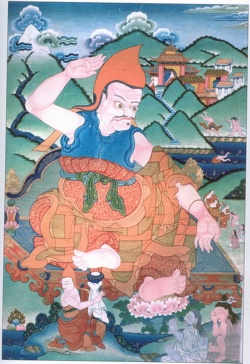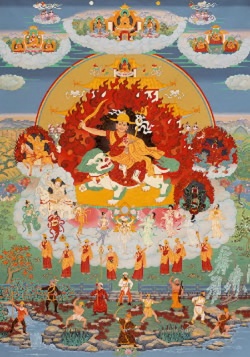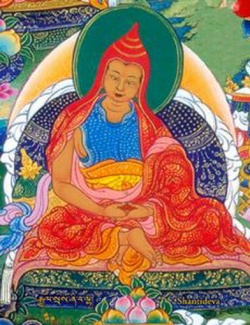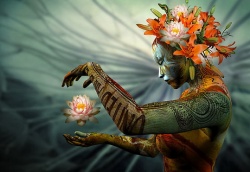Self and consciousness
The result is that greed, hatred and all other klesas are eradicated, because they depend on the duality of grasper and grasped.
For Candrakirti,3 3 and consequently in (Prasangika-Madhyamika, non-duality means prajiia which is free from both the extremes of the view of permanence and the view of annihilation. Thus, it is an other word for the epistemological principle of madhyamika and not an ontological or psychological description of the nature of reality concerning the duality of matter and consciousness. This is precisely the basic point of difference between Prasangika and Yogacara-Svatantrika- Madhyamika but mainly between Prasangika and Yogacara/ Cittamatra.
b) Yogacara
With regard to the Lankavatara-Sutra D.T. Suzuki3 4 has observed that three terms refer to the same reality of the deepest level of consciousness from different angles and on different historical background : 1. citta, which from the very beginning of Buddhist history of thought was related to the theory of perception and functions of the mind,
2. alayavijnana, which is the most comprehensive psychological term in relation to the w/waf/ra-tradition,
3. tathagata-garbha, which is a religious term referring to the possibility of liberation for everybody. Citta in a general sense refers to all possible mental processes, but in a specific sense it is different from manas and the vijnanas of the different senses. They signify specific functions, whereas citta is the "principle of unification by which all the activities are understood as issuing from one centre".
3 5 Manas,
33. Candrakirti, Supplement to Nagarjuna's Treatise on the Middle Way, quoted acc. to Wilson, op. cit., pp. 4f. note 5. 34. D.T. Suzuki, Studies in the Lankavatara Sutra, Routledge (London), 1930, p. 254.
3 5 . Suzuki, op. c i t . , p. 248.
however, develops within the citta, and it has two functions, (a) it reflects (manyati) on citta and (b) makes citta see itself as object iyidiyate). During this process of differentiation within the one citta the karmic seeds {bija), stored up nowhere else than in the citta (and in this connection usually called alayavijnana), get actualized. The Lankavatara Sutra puts it this way: cittena ciyate karma..., Karma is accumulated by consciousness and structuralized by the analytical function of consciousness - jiianena ca vidhiyate.36 The result is that citta gets "enveloped" by the cloud of vc7sa/?f7-formations which Suzuki calls very appropriately "habitenergies". In early Buddhism these caittas or cetasikas were really distinct realities besides the contentless citta.
In Yogacara they are just phases in the process of consciousness which explicates the implicate complexity of the one citta. Therefore, in early Buddhism one moment of consciousness is the combination of citta and the accompanying caittas, whereas in Yogacara one moment of consciousness is only one phase of the citta though differentiating different aspects of its own.3 7 There are a view beautiful passages in the Lankavatara , and I quote according to Suzuki (p.256f.): "The Citta is in its original naturel pure, but the Manas and others are not and by them various karmas are accumulated, and as the result there are two sorts of impurities". (754)
"On account of external defilements from the beginningless past the pure self is contaminated: it is like a soiled garment which can be cleansed". (755) "As an unintelligent man seeks for the abode of sweet sound in the body of the lute, conch-shell, or kettle-drum, so does he look for a soul within the Skandhas". (757) This passage makes it quite clear that the pure citta is not to be misunderstood as a kind of self or substance or individual reality besides anything else.
36. Lankavatara Sutra, 158-3, quoted acc. to Suzuki, op. cit., p. 401. 37. A.K. Chatterjee, op, cit., p. 113.
The citta now becomes obscure. Hence, the citta is full of phenomena and experience of past karmic events, and all what is a possible phenomenon of experience is nowhere else than in this citta, in fact, it is citta. Even the dhatus do not exist apart from it i.e. they are empty of inherent existence, as the Lankavatara explicitely mentions in Sagathakam 20. Cittamatra therefore means the ground of all differentiation which is beyond phenomenal reality, and that is why cittam hi sarvam, as Sagathakam 134 has it. But when this ground (citta) evolves (pravartate), all forms come into (dependent) being.
Thus, what is stated here is a radical ontological non-dualism. All forms, energies, formative energies, subtle realities or gross matter is nothing but explication of an implicate potentiality.
This, of course, is possible only on the basis of sunyata which can unify all different aspects and levels of reality because it allows for their mutual interpenetration. This, in turn, is not just an ontological or epistemological device, but a soteriological instrument in order to bridge not only the different worlds of samsara and nirvana, but the defiled and undefiled consciousness.3 8 This, again, is the great insight in Mahayana underlying all schools.
The much disputed alayavijnana is no "self" in the sense of an inherently existing entity at all. It is precisely this ground
38. Garma C . C Chang puts it very w e l l : "It is because of Sunyata that the merging or dissolving of all dualities is made possible. This we have seen in the discussion of the Not-Two Dharma Principle (or the Dharmagate of non-duality) mentioned before in the Vimalakirti Sutra. Without Sunyata, the unification of Samsara and Nirvana, the merging of the finite and infinity, and the interpenetration and mutual containment of all beings on ail levels would not be possible . . . without the realization of Emptiness, the infinite compassion and altruistic deeds of a Bodhisattva are not possible . . . The way to Buddhahood is to do all good deeds with a spirit imbued with Thorough Emptiness, free from all attachment". (The Buddhist Teaching of Totality, Allen & Unwin (London), 1972, p. 116f).
of potentiality, depending on everything else. It is one of the vijnanas, though the most fundamental one in so far as it stores all the karmic impressions of the past. It forms, as it were, the matrix for the functioning of all the other processes of consciousness. But in the Lankavatara it is identified with the Tathagatagarbha as the original and pure nature, the suchness of reality dormant in every being. No wonder that Mahamati got confused and asked the Buddha whether this is not a permanent self, very much like the atman. And here is the Buddha's answer: " 0 Mahamati, the doctrine of the ätman by the philosophers is not the same as my teaching of the tathagata-garbha.
For what the Tathagatas teach is emptiness (sunyata), limit of reality (bhutakoti), Nirvana, no-birth, noappearance, no-desire (apranihita), and such other conceptions, with which the tathagatagarbha is characterised, and by which the ignorant are saved from the occasion of cherishing a sense of fear about the Buddhist teaching of non-ego . . . " . 3 9 The vijnanas depend on the alayavijnana, and they in turn mistake phenomena for independently existing "things instead of realizing that they all are projections of different levels of citta. But when all the karmic seeds in the alaya are stilled and eradicated, emptiness appears. In other words: non-duality arises as soon as the discriminating factors within citta disappear.
This is an extremely brief attempt to characterize the nature of consciousness in Yogacara thought, all subtleties being neglected here. I doubt that it is useful to call cittamatra a form of idealism, as Suzuki does. Why? First because of the history of Yogacara thought. It is rather well established, that Vasubandhu in his Trimsatika does not speak about a cosmic consciousness, but about the appearance of things in an individual consciousness, i.e. in their subjectivity {atman)
39. Lankavatara Sutra, quoted acc. to Suzuki, p. 259f.
and their objectivity (dharma) both of which are only mental constructs.4 0 Though this, of course, is different in later Yogacara, it is the background of philosophical debate. But second with regard to fully developed Yogacara: because of the emptiness of citta. This is consciousness in Yogacara: an infinite continuum which has the potential of self-differentiation, but in itself, at its deepest level it is absolutely quiet and non-dual. All what happens, happens within this selfdifferentiation. But even this ground or deepest level is "nothing", it is empty of inherent existence, pure process, one could say.
What matters is not to hold a view of self or no-self. Even a "view of no-self" can become a fixed notion, a substantialized mental phenomenon, and thus turn into what Mahayana calls "inherent existence" or self! Emptiness also must be emptied. What remains is the continuous process of emptying. This is the nature or better the adventure of consciousness, its final ground which is no-ground, of course.
4. Conclusion
I will not try a synthesis here, much less a critical examination of the question how to proceed under a crosscultural perspective. I just would like to summarize a few basic distinctions which are essential for an understanding of consciousness in the context of sunyata in Mahayana-Buddhism without investigating the basic difference between Prasangika- Madhyamika and Yogacara concerning the subtle dualism (of mind and matter) of the first one and the radical nondual cittamatra-doctrine of the second one. My attempt is to show the implications of the whole discussion for our mental training on the basis of an understanding of the different levels of consciousness as presented in Mahayana.
40. Cp. the excellent study of Trimsatika by Th. A. Kochumuttom in his: A Buddhist Doctrine of Experience, Motilal Banarsidass (Delhi), 1 9 8 2/ esp. pp. 170ff.
1. The core of all Buddhist philosophy is the study of consciousness, because it is consciousness which is accountable for all actions, emotions and thoughts which are to be purified in order to attain liberation. Whatever consciousness is defined to be, all philosophical endeavour has this soteriological motivation.
2. Consciousness is the fundamental reality, a beginningless and endless continuum of processes. Buddhism refers to this continnum both in logical analysis and in direct meditative perception. Consciousness cannot originate from nothing nor from matter, and therefore its source is a former moment of consciousness. This is an important argument used to establish the rationality of belief in rebirth.
3. Some Sutras compare the ground of consciousness (citta) with an ocean and the different mental states or processes in consciousness (caitta) with the ripples on the surface of the ocean. In Yogacara citta is the one reality or a universal consciousness in which all processes emerge and, after their disappearance, leave formative traces (bija) for further processes. Even in what we call matter this conscious principle is latent, and the development of this conscious principle towards full maturity, which is Buddhahood, is the evolutionary process in Buddhism.
In Prasangika-Madhyamika, however, there is always an extremely subtle duality of most subtle mind (in Tibetan 'od gsal, the clear light) and most subtle matter, which is its supporting energy (prana, rlung).
4. The essential nature of consciousness is its emptiness with regard to inherent existence (sunyata), it is pure potentiality as process of its own luminosity and faculty of knowing. The most subtle level of this continuum is undestructible and lasting from birth to birth, being completely purified right into Buddhahood.
5. Consciousness is not only a store for information resulting from karmic processes, but it is the active process of knowing. Here, one differentiates between attentiveness (buddhi) and knowledge (nana). Only by intensification and purification of consciousness attentiveness can become so undivided and knowledge so clear that the ultimate nature of consciousness can be perceived directly. The purification is essentially an eradication of the klesas which produce karmic defilments of which the most fundamental one is the false notion of a substantial self as an entity of its own (svabhava).
This "self" tries to establish its wrong identity by all sorts of clinging and therefore intensifies the illusion of its existence by further illusion, greed and hatred. What is the problem of beings, therefore, is the wrong perception of an absoluteness of differentiated or individuated reality.
6. What is perceived in the direct perception of consciousness by a purified consciousness? The ultimate emptiness of consciousness is perceived, i.e. the most subtle level of the continuum of consciousness which has no limiting determinations whatsoever. It is no substance, but pure light beyond any conceptual perception and duality. It has no beginning and no end. It is always present in all beings. It is their ultimate nature.
7. From a theistic point of view the Buddhist philosophy of consciousness and emptiness allows a more comprehensive view of the person. What later was developed by East- Asian Buddhism with its doctrine of mutual interpenetration of i all phenomena (based on the Avatamsaka-Sutra) has relevance today for a unified world-view. The basic question is not self or no-self, but on a more comprehensive level: fragmentation or unity of reality.





